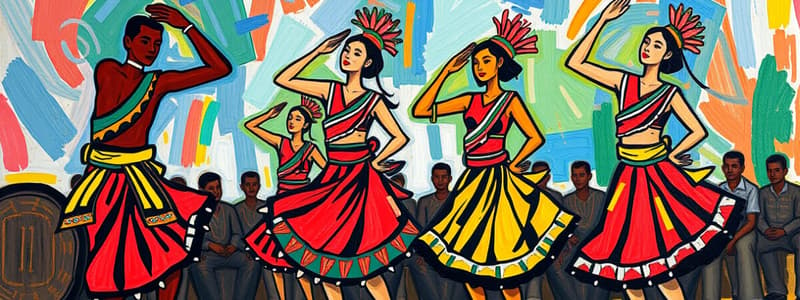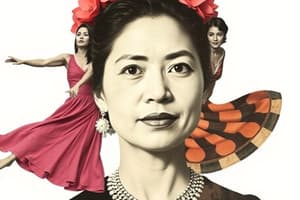Podcast
Questions and Answers
What is the original use of the saluting stick?
What is the original use of the saluting stick?
- For social activities
- For cultural education
- For combat training (correct)
- For traditional caroling show
Sakuting dance is only performed by girls.
Sakuting dance is only performed by girls.
False (B)
What is the name of the traditional Filipino martial arts incorporated in Sakuting dance?
What is the name of the traditional Filipino martial arts incorporated in Sakuting dance?
Arnis
Sakuting dance is traditionally performed during _______________ at the town plaza or performed house to house as a form of traditional caroling show.
Sakuting dance is traditionally performed during _______________ at the town plaza or performed house to house as a form of traditional caroling show.
Where did Sakuting originate from?
Where did Sakuting originate from?
The Spanish colonization allowed the practice of Arnis.
The Spanish colonization allowed the practice of Arnis.
What is the significance of the Sakuting dance?
What is the significance of the Sakuting dance?
Match the following with the correct description:
Match the following with the correct description:
Flashcards are hidden until you start studying
Study Notes
Folk Dancing Overview
- Folk dancing is often linked to social events and serves as a vital component of cultural education in various regions.
- Some folk dances are competitive, showcasing skill and tradition.
Saluting Dance
- Saluting is a Philippine folk dance highlighting a mock battle between Ilocano Christians and non-Christians.
- Traditionally performed during Christmas, it occurs in the town plaza or as a caroling act from house to house.
- Originally performed exclusively by boys, the dance involves the use of saluting sticks.
- Saluting sticks are typically striped or made of bamboo, approximately 1½ feet long with a tapered end, resembling a candle.
- The original function of the saluting stick was for combat training.
History of Sakuting
- Sakuting originates from the Abra province in northern Luzon.
- The dance reflects historical conflicts during Spanish colonization (1520-1898), where Ilocano Christians faced raids from mountain tribes.
- Sakuting depicts the struggle between lowland Christian natives and non-Christian mountain natives.
- It incorporates Arnis, a traditional Filipino martial art, using two sticks to mimic a fighting technique.
- Pre-Spanish colonization, Arnis was commonly practiced for self-defense.
- The Spanish colonial regime banned Arnis, prompting Filipinos to adapt it into cultural expressions like folk dances.
- The Sakuting dance not only narrates a historical conflict but also revives the use of Arnis, presented as a two-stick exercise performed to lively music.
Studying That Suits You
Use AI to generate personalized quizzes and flashcards to suit your learning preferences.




